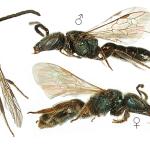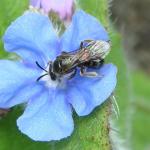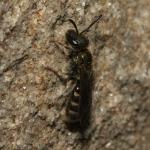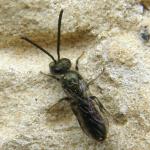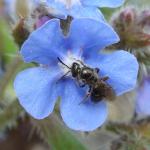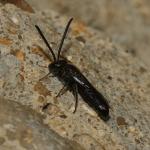Throughout England and Wales, the range extending from the Isles of Scilly to Kent, northwards to the Isle of Man (Nelson 1958), North-east Yorkshire (Archer 2002) and Cumberland. There are no records from Scotland or Ireland. In southern Britain and the Channel Islands it is usually a very common bee, colonising patches of exposed soil as nesting sites. Widely distributed in the western Palaearctic, from central Fennoscandia (Elfving 1968) south to north Africa and the Azores, and east to the Urals and the Caucasus (Ebmer 1988).
This species is not regarded as being scarce or threatened.
Virtually ubiquitous in lowland England, Wales and Ireland.
Females are active from late March to the end of October, males from late June to late October (exceptionally early November). Possibly bivoltine as R C L Perkins (G M Spooner pers. comm.) reported "a colony in a Paignton [South Devon] garden produced males and females in June: these females paired and provisioned cells, and gave a second brood in August". However, we now know that workers cannot be reliably distinguished from females (queens) and therefore there is some doubt about the accuracy of this observation.
L.morio is primitively eusocial. The females normally nest in large aggregations in exposed soil. Chambers (1949) reported that in a Bedfordshire site the females were so numerous that the air was strongly pervaded by their scent for a distance of several feet from the bank in which they nested.
Alder buckthorn (Frangula alnus) bloody crane's-bill, (Geranium sanguineum), bramble (Rubus spp.), burdock (Arctium spp.), carrot (Daucus carota), creeping buttercup (Ranunculus repens), dandelion (Taraxacum officinale), devil's-bit scabious (Succisa pratensis), field scabious (Knautia arvensis), garlic mustard (Alliaria petiolata), goldenrod (Solidago virgaurea), greater stitchwort (Stellaria holostea), ivy (Hedera helix), ivy broomrape ((Orobanche hederae), knotgrass species (Polygonum spp.), mayweed (Tripleurospermum spp.), primrose (Primula vulgaris), sea aster (Aster tripolium), sea campion (Silene uniflora), sheep's-bit (Jasione montana), speedwell (Veronica spp.), sow-thistle (Sonchus spp.), stonecrop (Sedum spp.), traveller's-joy (Clematis vitalba), water-dropwort (Filipendula vulgaris), wild mignonette (Reseda lutea) and willow (Salix spp.).
GHL Dicker (pers. comm.) observed Sphecodes niger around the nests of this species in Kent; the same species was also seen in large numbers flying over a nest site of L. morio on the Isle of Wight (pers.obs). M Edwards has also seen S. niger with L. morio in many situations (pers. comm.). Sphecodes geoffrellus and Nomada sheppardana may be additional cleptoparasites in Britain, as in Germany (Westrich 1989).
2005


